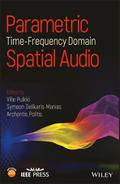Book Description
A comprehensive guide that addresses the theory and practice of spatial audio
This book provides readers with the principles and best practices in spatial audio signal processing. It describes how sound fields and their perceptual attributes are captured and analyzed within the time-frequency domain, how essential representation parameters are coded, and how such signals are efficiently reproduced for practical applications. The book is split into four parts starting with an overview of the fundamentals. It then goes on to explain the reproduction of spatial sound before offering an examination of signal-dependent spatial filtering. The book finishes with coverage of both current and future applications and the direction that spatial audio research is heading in.
Parametric Time-frequency Domain Spatial Audio focuses on applications in entertainment audio, including music, home cinema, and gaming—covering the capturing and reproduction of spatial sound as well as its generation, transduction, representation, transmission, and perception. This book will teach readers the tools needed for such processing, and provides an overview to existing research. It also shows recent up-to-date projects and commercial applications built on top of the systems.
- Provides an in-depth presentation of the principles, past developments, state-of-the-art methods, and future research directions of spatial audio technologies
- Includes contributions from leading researchers in the field
- Offers MATLAB codes with selected chapters
An advanced book aimed at readers who are capable of digesting mathematical expressions about digital signal processing and sound field analysis, Parametric Time-frequency Domain Spatial Audio is best suited for researchers in academia and in the audio industry.
